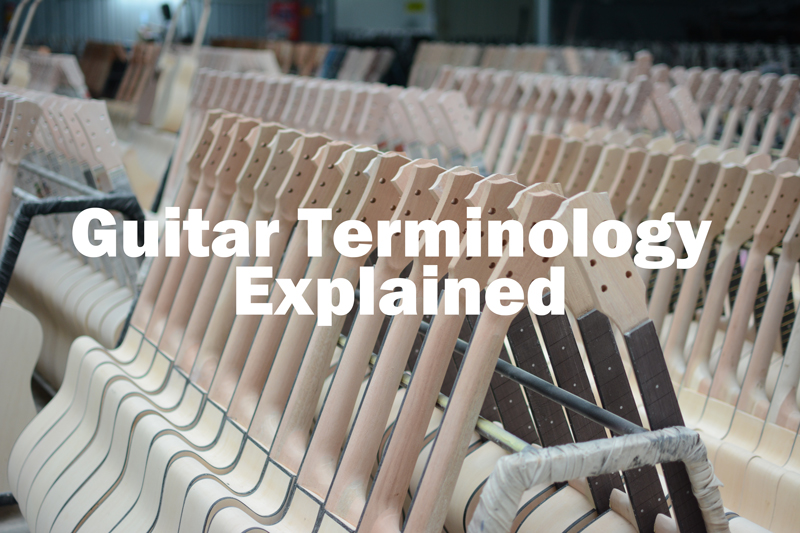Guitar terminology explained

A. "Emphasis" - a note or chord that needs to be emphasized or played louder. Tip: Pay attention to the dynamics and phrasing of the music to properly emphasize the emphasized notes or chords. B. "Acoustic Guitar" - a guitar that can be played without electronic amplification. Tip: Consider the type and quality of wood used in the construction of the guitar to achieve the desired sound. C. "Action" - the distance between the strings and the fretboard. Tip: Adjusting the string height can affect the playability and sound of the guitar. D. "ADT" (Automatic Double Tracking) - a technique that involves the quick repetition of a signal to produce an electronic effect that simulates the sound of two guitars playing simultaneously. Tip: Experiment with different ADT settings to achieve the desired effect. E. "Slide Playing" - a guitar playing technique that uses a metal or glass finger slide to play single notes or chords on the strings. Tip: Experiment with different finger slide materials and sizes to find the one that works best for you. F. "Bridge" - a device installed on the guitar body to hold the strings in place. Tip: Consider the type and quality of the bridge to achieve the desired tone and sustain. G. "Capo" - a clamp that can be attached to the guitar neck to raise the pitch of the strings. Tip: Use a tuner to ensure that the guitar is properly tuned after using a capo. H. "Chords" - a group of two or more notes played simultaneously to create a chord. Tip: Learn the basic chord shapes and progressions to play a wide variety of songs. I. "Harmonizer" - an electronic effect that simulates the sound of multiple instruments playing together. Tip: Experiment with different harmonizer settings to achieve the desired effect. J. "Delay" - the delay or echo effect produced when a sound wave is reflected. Tip: Use a digital delay pedal to create a variety of delay effects. K. "Muting" - a technique used to mute the strings to prevent unwanted noise or to create a special effect. Tip: Use the palm of your picking hand or a dampener to mute the strings. L. "Distortion" - a distortion effect commonly used in rock music created by overdriving an amplifier or using a distortion pedal. Tip: Experiment with different distortion effects to achieve the desired tone. M. "Electric Guitar" - an acoustic guitar that can be amplified using electronic equipment. Tip: Use a pickup or a microphone to amplify the sound of the guitar. N. "Reverb" - the sound produced when a sound wave is repeated and amplified. Tip: Use a digital delay or reverb pedal to create a variety of reflection effects. O. "Fingerpicking" - a picking technique that involves using the fingers to pluck the strings. Tip: Experiment with different fingerpicking patterns to create a variety of rhythms and textures. P. "Chord Melody" - a playing technique that involves pressing down on the strings with both the left and right hands to create chords. Tip: Use the fret markers on the fretboard to help you find the right positions for your fingers. Q. "Fuzz Pedal" - a pedal effect used to create a fuzzy, distorted sound. Tip: Use a fuzz pedal to create a variety of distortion effects. R. "Guitar Synthesizer" - a guitar with a built-in synthesizer that can change the sound of the guitar. Tip: Use a MIDI guitar or a guitar synth to create a variety of sounds and effects. S. "Headstock" - the top part of the guitar neck that holds the tuning knobs. Tip: Use the tuning knobs to adjust the pitch of the strings. T. "Humbucker" - a pickup with two sets of coils that produce a thicker, more full-bodied sound. Tip: Experiment with different pickup configurations to achieve the desired tone. U. "Tuning Machines" - a mechanical device used to adjust the tension and pitch of the strings. Tip: Use a tuner to ensure that the guitar is properly tuned after adjusting the string tension. V. "MIDI" (Musical Instrument Digital Interface) - an electronic device used for data exchange between musical instruments, such as synthesizers, sequencers, mixers, and effects processors. Tip: Use a MIDI controller or a MIDI guitar to control other electronic instruments and effects. W. "Nut" - a device located at the top of the fretboard that holds the strings in place. Tip: Adjust the position of the nut to achieve the desired string height. X. "Chromatic Scale" - the twelve-tone scale used in Western music. Tip: Learn the notes of the scale and the intervals between them to play melodies and chords. Y. "PA System" (Public Address System) - an electronic system used for amplifying sound for an audience. Tip: Use a PA system to amplify the sound of the guitar for live performances and events. Make sure to adjust the volume and EQ settings to achieve the desired sound.
#acousticguitar #nut #Emphasis #TuningMachines #Action #Slide #Muting #Bridge #capo #Chords #Harmonizer #Distortion #Reverb #Delay #FuzzPedal








